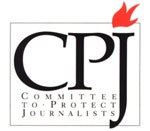The interactive guide, created by CPJ experts, provides a blueprint for local and international journalists of all experience levels to take concrete steps for their physical and digital safety. Protecting digital information, preparing for armed conflict, covering organised crime and corruption, and mitigating the risk of sexual violence are among vital topics included in the guide.
"Today's journalist is covering an increasingly dangerous world, operating in a climate where journalists are not only frequently killed, but murdered with impunity," said CPJ senior adviser for journalist security Frank Smyth, who is the main author of the guide. CPJ is also launching a journalist security blog led by Smyth. "Investigating corruption or abuse of power can be more dangerous in many nations than covering combat. In this climate, journalists need to know how to protect their information, their sources, themselves, and their families."
A major threat
The prospect of being targeted is a major threat facing journalists today. On average, 30 journalists are murdered around the world each year, CPJ research shows, and the killers evade justice in nearly all cases. Local reporters are most at risk. Beat reporters covering politics, corruption, crime, and conflict are particularly vulnerable to attack or imprisonment. Furthermore, in a 2011 report, close to 50 journalists told CPJ they had been sexually victimised while on assignment.
About half of the journalists jailed at any given time work primarily online and approximately half are freelancers, according to CPJ research. Bloggers, videographers, and citizen journalists increasingly report for evolving media networks with little or no support or training. CPJ has documented cases in which authorities have presented journalists with logs of text messages as an implied threat or as evidence of anti-state activity.
Better protection
"Information security means defending your research, notes, details of contacts, images, audio and video files, even your itinerary; all data that if lost or confiscated could not only derail a story but put a journalist and others at risk," said Danny O'Brien, CPJ's Internet advocacy coordinator and author of a section of the guide. "With this guide, we want to protect your virtual data better, as well as shed light on the importance of understanding the motives and capabilities of those who may want to obtain your information."
The CPJ Journalist Security Guide is available online in Arabic, English, French and Spanish. It can also be downloaded in PDF, as an iBook for iPad, and in e-reader format for Kindle and Nook. In addition to 10 chapters on key issues, the guide includes checklists, a pre-assignment security assessment worksheet, and a comprehensive list of resources for insurance and security training, among others.
Publication of the guide was made possible by grants from the Adessium Foundation, the Omidyar Network, and the RealNetworks Foundation.
























